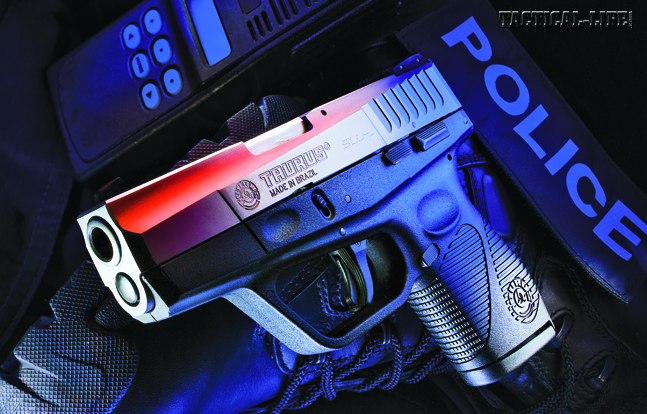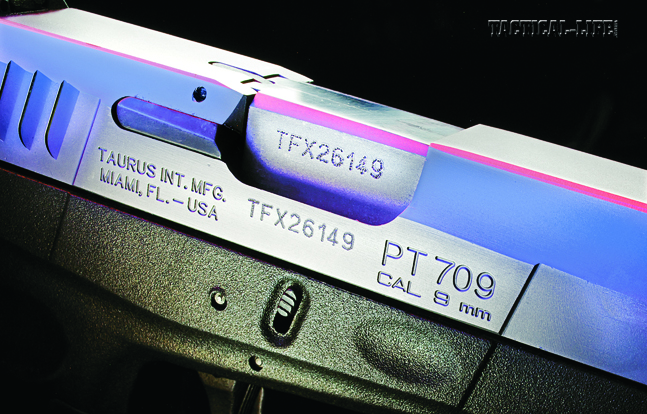A few years ago, Taurus rolled out its new “Slim” line of compact autopistols. Available in 9mm or .40 S&W with either a blued or stainless slide, these single-stack pistols are described alternately as “single actions” and “double/single actions.” Designed for the burgeoning concealed-carry market, Taurus’ Slim semi-autos are clearly useful for “backup gun” status for LEOs due to their compact size and powerful chamberings.
It wasn’t long ago that small autopistols were chambered for small calibers. Some of us remember the days when such guns were in .32 ACP, like the Colt Model 1903 Pocket Hammerless, and .380 ACP, like the Colt M1908 and Remington Model 51. In the current era, increasingly small guns chambered for what we consider service calibers are becoming the norm. One of the more recent iterations is the Taurus 709, which I recently received for testing.
The common perception for years was that the autopistol was just too unreliable to be a backup gun. It’s true that deep-concealment guns quickly load up with lint and other debris, limiting the chance the gun will work as needed, if you don’t use a good holster. I carried one such gun, a 10-shot 9mm that’s considerably larger than the Taurus 709, in an Alessi Ankle Holster from 2001 to 2004 as a backup to a larger 9mm pistol. On one occasion, to use up the duty ammo that’d been in it for three months, I shot the gun for my qualification. At the first shot, I recall a plume of burning lint and a cloud of dust around the fired gun. An onlooker thought the gun had blown up, but I continued to fire. As shown by this example, the modern autopistol has become quite reliable and it’s making inroads into the backup gun role normally owned by revolvers.
Advertisement — Continue Reading Below
Gun Details
The Taurus 709 is a 9mm pistol that weighs in at 19 ounces empty. Taurus offers it with a black polymer frame and either a blued or matte stainless steel slide. My test pistol, officially the 709SS, came with the matte stainless slide. It’s a striker-fired semi-auto (meaning there’s no “hammer,” per se) with a slide-locking manual thumb safety on the left side of the frame. Press up for “safe” and down for “fire.” When the lever is down—meaning the gun is capable of firing—you’ll see a red dot on the slide. Taurus provides two steel magazines with the pistol, and each has a seven-round capacity.
The angular slide is beveled, narrowing as you go from the rear to the front, in what’s come to be called the “high power” cut. This aids in reholstering, and if you’re prone to run the slide from in front of the ejection port, while there isn’t much room for that with the 709, this slimmed-down portion gives you enough purchase to do a chamber check.
There’s a tactile loaded-chamber indicator at the rear of the ejection port that protrudes when the chamber is loaded. The sights have the requisite three white dots—one on the front post and two on the rear sight. The rear sight is adjustable for elevation and windage. The currently fashionable integral gun lock is just below the rear sight on the right side of the slide. Using the supplied key, you can turn the lock to disable the gun.
Advertisement — Continue Reading Below
Just above the trigger, the frame has small depressions on each side, known as memory pads, where you can place your trigger finger when you’re not ready to fire. Behind the depressions is the ambidextrous takedown lever. The trigger itself has a safety paddle in its face. The paddle has to be depressed to move a trigger block out of the way and allow the trigger to roll back to fire the gun. Just in front of the thumb safety, also on the left side of the frame, is the slide stop. Not blocky, bulky or in the way, it’s nicely placed and works as intended.
Now for the unique nature of the trigger system. The Taurus 709 has two “actions.” One is the trigger condition from loading or firing. When the slide runs aft and comes back into battery, the trigger has a light, seemingly spring-free travel to a firm point. A slight nudge and the striker falls. That’s the way it always happens if everything works as it should. In this mode, the striker is fully cocked by the cycling of the slide.
But what happens when a chambered round does not fire? What happens if you get a click instead of a bang? Well, current wisdom is to tap the magazine floorplate to ensure the magazine is seated and vigorously work the slide, hopefully feeding a hot cartridge into the chamber. With the 709, however, you can just pull the trigger again. The pistol is capable, with a secondary longer trigger pull, of cocking and releasing the striker for a “second-strike” capability.
Advertisement — Continue Reading Below
Let’s say that you drew the gun to repel an assault. The first round fires, striking the threat (who fails to immediately drop or vaporize like in the movies) and you press the trigger again for a follow-up shot. It fails to fire, the threat is still up and you press again. Either it’ll shoot at this stage or it won’t. If it does not fire at this point, you need to cycle the gun to chamber a new round. In my experience, the most common cause of failures to fire is not having a round in the chamber. That could be because you failed to fully seat a magazine or you just forgot to run the slide. In that case, you can click on that empty chamber until eternity passes, but there will be no resulting gunshot. But, if you have a round chambered that failed to fire and you pulled again there is a chance, however slight, that the second strike will light it up. For me, if I find myself in that situation, I’ll do what I’ve done during the past 27 years of carrying semi-autos to remedy the problem.
Range Time
Using my Lyman Trigger Pull Gauge, I found the “single-action” (pre-cocked) trigger pull to be around six pounds after a long take-up. This is not a long hard pull, like a double-action (DA) revolver, but a soft, almost weightless start to a final nudge. The nudge is likewise light. The “second strike” or DA trigger pull was around 7 pounds and change.
I selected three rounds for testing the 709’s accuracy: DoubleTap’s 124-grain bonded JHP +P, which appears to be loaded with a Speer Gold Dot bullet, Black Hills’ 115-grain JHP EXP and Remington’s 115-grain UMC ammo. While 3-inch-barreled handguns are generally tested at 7 yards, I evaluated the Taurus 709 at 15 yards to really see its capabilities. I found the gun, with this ammo, to be headshot-capable at that distance under ideal circumstances. The accuracy and velocity figures were remarkably stable and consistent across the rounds tested. All loads shot low and left for me, with the Remington UMC being the most off-base. The first group was tightly clustered at around the extreme 7 o’clock on the target, with one round striking the metal frame.
Advertisement — Continue Reading Below
The 709 has adjustable sights, so why not adjust them? If it were my gun, perhaps. But like all small handguns (revolvers and semi-autos alike), the sample was extremely susceptible to variations in grip and hold. While I had no stoppages of any kind, I did hit the slide stop with my thumb once during firing, locking the slide open on a loaded magazine.
I loaded the pair of supplied magazines to capacity and inserted them with the pistol in battery. The magazines were easily seated, telling me that an in-battery reload would be facilitated. Using the “Municipal Police Training Council Combat Target” from Kleen-Bore—the old “thug” target with overlaid B27 scoring rings and the K-zones from the old B21—I was able to keep all hits in the 8-ring equivalent in the body when shooting from 5 to 15 yards. Called headshots went into the head. Firing at 25 yards and compensating for my hold and trigger manipulation, I found it easy to make hits. With the Taurus 709, the sights can be adjusted to match the shooter’s issues. Unlike some other small 9mms, the Taurus was not abusive to shoot. Even the DoubleTap 124-grain bonded JHP +P loads were controllable, though split times lengthened.
I had a Remora “No Clip” Holster that fit the Taurus 709 and sought to use it at the range. The outside skin of the pouch holster is a rubberized material. The inner padding is slick and should let the gun out easily. The outside material was meant to cling to fabric, to keep the holster still as you draw. When I used the Remora “No Clip” as an inside-the-waistband holster as it was intended, draws were smooth and fumble free.
Advertisement — Continue Reading Below
Final Thoughts
The gun was so far shooter friendly, and I thought I’d take it along to an acquaintance for examination. Lt. Chuck Haggard is pretty hard on guns, but I also consider him an expert. He removed his revolver from his ankle holster and tried the Taurus 709 in it. It fit well.
Like me, he concluded that the rear sight notch wasn’t deep enough and the front sight wasn’t high enough, but on a compact gun space is at a premium. However, the sights are so much better on the Taurus 709 than on the pocket guns of old that there is no comparison.
When Lt. Haggard concluded shooting, he wondered about the gun’s durability, but that’s the kind of thing that concerns pistol packers about backup guns—revolver or auto. The backup gun is the last ditch, almost the last line of defense. If anything has to work, it does. In its defense, the Taurus 709 fired, extracted, ejected, cocked, fed, locked and fired again as long as we shot it. Like all small guns, it’s very dependent on grip and hold. It did everything we asked of it and did it well. For more information, visit taurususa.com or call 800-327-3776.
Advertisement — Continue Reading Below
































